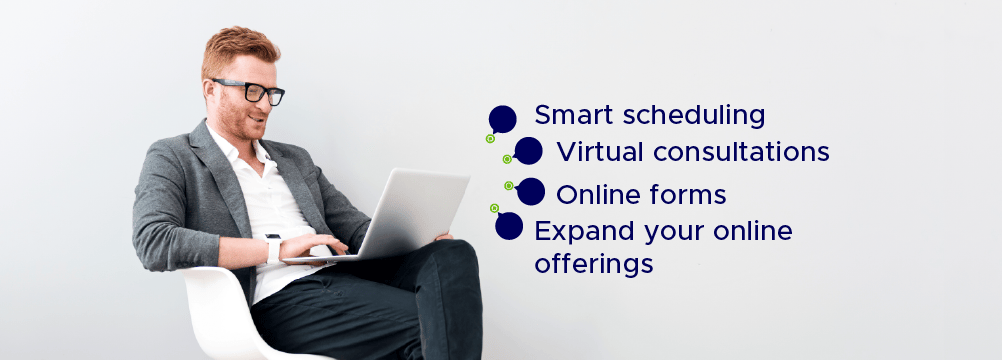Government offices aren’t exactly synonymous with short wait times.
When most people think of the DMV, tax authorities, or a county government building, they think of long lines and slow service.
Unfortunately, that’s a reputation that’s been earned. In some of Michigan’s busiest public services offices, average wait times exceed an incredible two hours.
Of course, it’s no secret why that’s the case for anyone involved in providing a civic service. Government offices often offer a wide range of services and must cater to citizens with a whole host of different needs and backgrounds. And they usually just don’t have the staff to be able to offer a smooth and speedy service to citizens, as hard as they try to.
Luckily, there’s plenty you can do to reduce wait times at your government office by leveraging the latest technology.

Here’s a closer look at six of the biggest:
Expand your online offerings
Until recently, most government services had to be provided in-person. If someone needed to access a service, they had to physically visit a government office and join the back of a line.
But technological innovations now allow you to seamlessly provide civic services online. Renewing a driver’s license or a passport is now as easy as filling out a form online.
The more citizens that can access the service they need online, the less of a strain is put on your staff, freeing them up to provide a higher quality service to the citizens who choose to access your services in-person.
And the fewer people in your government office, the less time each person will spend waiting in line.
Finally, if someone doesn’t meet the right requirements to access the service they need or didn’t bring the documents they need to a branch, they’d have to waste time queuing for a service they can’t access.
If the same citizens tried to access that service online, they’ll find out they’re not eligible much sooner. If they need a document they didn’t realize was required, they’re at home to be able to go and grab it – or they can order it online with a few clicks of their mouse.
The more services you offer online, the fewer people will need to visit your government office. This change alone will transform every citizen’s experience of accessing your service, as your entire operation will run so much smoother.
Smart scheduling
Appointment scheduling software can make crowded government offices a thing of the past.
Instead of having to turn up and hope they’re lucky with the length of the line, citizens can schedule an appointment online then arrive at their allotted time.
By allowing citizens to look online to see which branch has the shortest wait times, you’ll empower them to access the service they need as efficiently as possible. This will not only provide them with a much better citizen experience but also help manage footfall in each of your government offices.
Smart scheduling software also automatically reminds citizens about what they need to bring along to their appointment, so they never end up being unable to access the service they need. This helps ensure the best possible citizen experience and streamlines your services.
This all makes your entire operation more efficient, improving the experience for citizens and your staff.
And when things are less hectic for your frontline staff, they’ve got more headspace and capacity to provide a quality citizen experience – something that’s a lot more difficult to do when you're overwhelmed and trying to process each citizen as fast as possible.
Online forms
Providing citizens with the option to fill the relevant paperwork they need to complete in order to access service before they arrive for their appointment is another simple way to reduce wait times in your government office.
This will reduce the number of citizens on your premises at any one time (improving optics and perceived wait times). Plus, it will ensure every citizen has access to all the information they need to complete the form with all the correct information, as they’ll have any supporting documents to hand at home.
Plus, incomplete and incorrect forms won’t be accepted by an online system, meaning citizens will never have to go through the frustrating experience of filling out the same form twice if they do it incorrectly the first time.
Empowering citizens to fill out paperwork in advance of their appointment can shave ten or fifteen minutes off every visit, streamlining your entire operation while also improving each citizen’s experience.
Assign staff based on customer needs
Q-Flow arms government services with data you can use to identify peaks and troughs in customer activity for the time of year, month, week, and day. You can then use this real-time information to plan staff schedules, so your department runs as efficiently as possible at all times.
The Q-Flow system also automatically assigns citizens to the member of staff best suited to help them based on their specific needs. This ensures each citizen gets the service they need as quickly as possible, making your entire operation run more smoothly.
And when everything runs more smoothly, citizens accessing your services and your staff will have a far less frustrating experience.
Be upfront about wait times
A big reason waiting in line is so painful is the fact you don’t know how long you’re going to be there. Should you bother sticking around, or will that take an age? Do you need to rearrange your plans, or will you only be another ten minutes?
Everything goes so much smoother if you communicate waiting times to citizens so they can plan around them.
Systems like Q-Anywhere allow you to publish real-time wait times online and on digital displays in your waiting room. If wait times change, citizens are automatically notified through a mobile notification and across on-premises digital signage.
Virtual consultations
Last but not least, today’s government offices can take consultations themselves online through video appointments. This removes the need for citizens to have to come onto premises at all to ensure everything runs as smoothly as possible.
Your citizens will have a much better experience taking their appointment from the comfort of their own home rather than having to make a trip for it. They can simply slot it into their schedule at their own convenience rather than having to head to a government office and wait in line.
And if their appointment is delayed, they can continue with things at home or the office rather than having the frustrating experience of having to stand around in a waiting room.
Want to reduce wait times in your government office?
Discover how our next-generation queue management software can improve the citizen experience across government services and transform the way citizens interact with your services through these six features (and many more).




